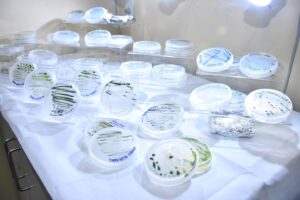
The National Center for Genetic Engineering and Biotechnology (BIOTEC), has unveiled an innovation in the field of sustainable aquaculture with the introduction of “AquaJade”, a pioneering application of green microalgae to control diseases that have posed significant challenges to the industry. Developed by BIOTEC researchers, Dr. Vanvimon Saksmerprome and Dr. Patai Charoonnart, “AquaJade” promises to reshape the landscape of shrimp farming by addressing critical disease-related setbacks and promoting environmentally-friendly production practices.
The Thai aquaculture industry has experienced a notable decline in its shrimp exports over the past decade, from producing 400,000 tons valued at £2.7 billion in 2010 to a mere 148,000 tons worth £1.1 billion in 2022. “How could one of the country’s largest exports be significantly diminished in production?” a question posted by Dr. Saksmerprome. This staggering reduction in production can be attributed to a combination of factors, including economic downturn in key markets, fierce competition from rival countries, and, most notably, the persistent challenge of pathogen outbreaks. Such outbreaks have led to devastating losses, often reaching up to 60% of the total yield, crippling the industry’s growth prospects. The management of infection using antibiotics or other chemotherapeutic agents that target bacterial pathogens and eukaryotic parasites is widespread within the aquaculture industry. However, Dr. Charoonnart highlighted that this approach lacks the capability to safeguard against viral diseases and could potentially have detrimental effects on the environment. This gives rise to worries about potential antibiotic contamination within the product, as well as the promotion of drug resistance among various pathogens and parasites. In response to these pressing challenges, “AquaJade” introduces a paradigm shift in disease management within the aquaculture sector. “AquaJade” harnesses the power of green microalgae, a natural food source for many small aquaculture animals including larval shrimp and fish fry, to combat pathogens in an eco-friendly manner.
 Dr. Saksmerprome explained that “recent advances in the genetic engineering of green microalgal species are now making possible the development of bespoke strains for oral delivery of novel anti-microbial agents, as well as of other beneficial recombinant molecules, including dietary enzymes such as phytases and cellulases.” The novel anti-microbial agent involves expressing double-stranded RNA in the green microalga and feeding extracts to shrimp larvae, as an effective means of interfering with viral infection. White Spot Syndrome Virus (WSSV) is the causative agent of White Spot Syndrome Disease (WSSD) in shrimp, including commercially relevant species such as black tiger prawns, king prawns, and Atlantic white shrimp.
Dr. Saksmerprome explained that “recent advances in the genetic engineering of green microalgal species are now making possible the development of bespoke strains for oral delivery of novel anti-microbial agents, as well as of other beneficial recombinant molecules, including dietary enzymes such as phytases and cellulases.” The novel anti-microbial agent involves expressing double-stranded RNA in the green microalga and feeding extracts to shrimp larvae, as an effective means of interfering with viral infection. White Spot Syndrome Virus (WSSV) is the causative agent of White Spot Syndrome Disease (WSSD) in shrimp, including commercially relevant species such as black tiger prawns, king prawns, and Atlantic white shrimp.
Dr. Saksmerprome further explained that “in the “AquaJade” feeding trial, groups of post-larval shrimp were fed for four days with either standard feed or feed mixed 1:1 with dried “AquaJade”. On the last day of the experiment, the survival of infected shrimp without treatment was less than 10%, compared to the remarkable approximately 70% survival in the shrimp groups receiving AquaJade.”
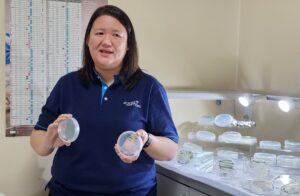
To ensure safety and practicality, the microalgae biomass is processed through a drying method, effectively eliminating the risk of environmental contamination with genetically modified species. Dr. Charoonnart revealed that the resulting dried powder is suitable for incorporation into shrimp feed, offering a promising avenue for disease prevention and sustainable aquaculture.
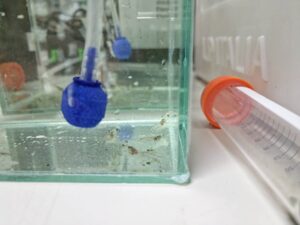
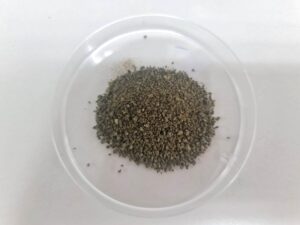
While AquaJade’s potential to revolutionize the industry is undeniable, challenges remain on the path to large-scale adoption. The production of genetically engineered algae requires compliance with regulations, requiring indoor cultivation under controlled conditions. Additional investigation is necessary to determine the precise shelf-life and optimal dosage for effective protection. This information will enable a comprehensive techno-economic evaluation and calculation of cost per protective dose. As the aquaculture landscape evolves, Thai shrimp farmers and exporters are presented with an opportunity to re-define their business models, embracing premium shrimp production that aligns with modern consumers’ increasing emphasis on sustainability and climate change impact. “AquaJade” emerges not only as a catalyst for production efficiency but also as a symbol of environmentally-conscious practices.
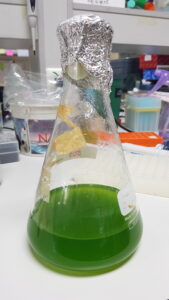
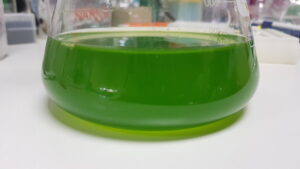
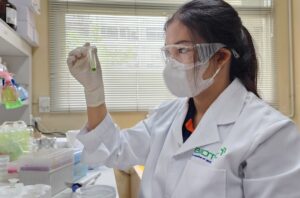
With support from governmental sectors, private investors, and all stakeholders involved, “AquaJade” is poised to attract global investment interest. “Through collaboration with key industry players, we remain committed to translating our findings into tangible benefits for shrimp producers, exporters, and all stakeholders, introducing a new era of sustainable competitiveness for Thailand’s shrimp industry” concluded Dr. Saksmerprome.
